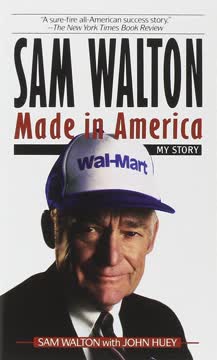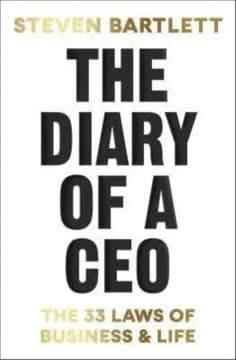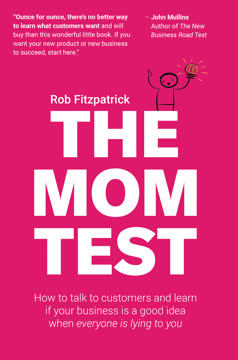मुख्य निष्कर्ष
1. जल्दी शुरुआत करें: जब तक आप शुरुआत नहीं करते, तब तक आप सीखते नहीं
"जब तक आप शुरुआत नहीं करते, तब तक आप सीखते नहीं।"
विश्लेषण में फंसने से बचें। कई नए उद्यमी योजना बनाने के चरण में ही अटक जाते हैं, विस्तार से व्यापार योजना बनाते हैं और बाजार अनुसंधान करते हैं। लेकिन सबसे महत्वपूर्ण सीख असली दुनिया के अनुभवों और ग्राहकों के साथ बातचीत से मिलती है।
तेजी से सुधार अपनाएं। महीनों या वर्षों तक अपने विचार को परिपूर्ण करने की बजाय, अपने उत्पाद या सेवा का एक बुनियादी संस्करण एक सप्ताह के भीतर लॉन्च करें। इससे आपको तुरंत प्रतिक्रिया मिलती है, आवश्यक बदलाव कर सकते हैं और ग्राहक की वास्तविक जरूरतों के अनुसार अपने प्रस्ताव को बेहतर बना सकते हैं।
असफलता से सीखें। लेखक अपने व्यक्तिगत अनुभव साझा करते हैं जहाँ उन्होंने कई असफल प्रयास किए, लेकिन अंततः WP Curve के साथ सफलता पाई। ये अनुभव बताते हैं कि कार्रवाई करना और सफलताओं व असफलताओं दोनों से सीखना कितना जरूरी है ताकि एक सफल व्यवसाय खड़ा किया जा सके।
2. विचार, क्रियान्वयन और मेहनत पर ध्यान दें
"विचार, क्रियान्वयन और मेहनत—ये तीन तत्व हैं जो किसी स्टार्टअप को सफल बनाने के लिए जरूरी हैं।"
तीनों तत्वों का संतुलन बनाए रखें। केवल एक अच्छा विचार होना व्यवसाय में सफलता के लिए पर्याप्त नहीं है। प्रभावी क्रियान्वयन और लगातार मेहनत भी उतनी ही महत्वपूर्ण हैं।
विचार मायने रखता है। ऐसा विचार चुनें जो किसी वास्तविक समस्या का समाधान करे, बाजार में उसकी मांग हो और जो आपकी क्षमताओं व रुचियों के अनुकूल हो। आसान रास्तों या तात्कालिक लाभ के पीछे न भागें।
क्रियान्वयन सबसे अहम है। अपने उत्पाद या सेवा को उद्योग के शीर्ष स्तर के बराबर देने पर ध्यान दें। ग्राहक की प्रतिक्रिया और बाजार की मांग के अनुसार लगातार सुधार करते रहें।
लगातार मेहनत करें। जो काम करना है, उसे दृढ़ता और लगन से करें। इसमें कंटेंट बनाना, नेटवर्किंग, कॉल करना या ग्राहक प्राप्ति और व्यवसाय वृद्धि के लिए जरूरी अन्य गतिविधियाँ शामिल हो सकती हैं।
3. 7 दिनों में न्यूनतम व्यवहार्य उत्पाद (MVP) बनाएं
"छह महीने खर्च करने की बजाय, केवल उतना ही काम करें जो आपके उत्पाद या सेवा की असली परीक्षा ले सके।"
अपने MVP को परिभाषित करें। उन मुख्य फीचर्स या सेवाओं की पहचान करें जो आपके ग्राहकों की समस्या का समाधान करने के लिए आवश्यक हैं। अनावश्यक तत्वों को बाद में जोड़ा जा सकता है।
मैनुअल प्रक्रियाओं पर ध्यान दें। जटिल स्वचालित सिस्टम बनाने के बजाय, मैनुअल प्रक्रियाओं से शुरुआत करें जो ग्राहक अनुभव की नकल कर सकें। इससे आप जल्दी लॉन्च कर सकते हैं और वास्तविक प्रतिक्रिया प्राप्त कर सकते हैं।
ग्राहक मूल्य को प्राथमिकता दें। सुनिश्चित करें कि आपका MVP ग्राहकों को वास्तविक मूल्य प्रदान करता है, भले ही वह पूर्ण या पूरी तरह से फीचरयुक्त न हो। उद्देश्य है अपनी धारणाओं का परीक्षण करना और ग्राहक व्यवहार व पसंद के बारे में डेटा इकट्ठा करना।
सफल MVP के उदाहरण:
- AppSumo: Reddit पर एक सॉफ्टवेयर डील बेचकर शुरुआत की
- Underground Cellar: एक पार्टी के माध्यम से वाइन अपग्रेड कॉन्सेप्ट का परीक्षण किया
- Baremetrics: 8 दिनों में Stripe के लिए बुनियादी एनालिटिक्स लॉन्च किया
4. सरल और यादगार व्यवसाय नाम चुनें
"दुनिया के शीर्ष 25 ब्रांडों में से हर एक का नाम 12 अक्षरों या उससे कम का होता है।"
नाम छोटा और सरल रखें। ऐसा नाम चुनें जो लिखने, बोलने और याद रखने में आसान हो। जटिल या काल्पनिक शब्दों से बचें जो संभावित ग्राहकों को भ्रमित कर सकते हैं।
भविष्य की वृद्धि को ध्यान में रखें। ऐसा नाम चुनें जो विस्तार की अनुमति देता हो और आपके व्यवसाय को किसी विशेष उत्पाद या स्थान तक सीमित न करे। व्यापक नाम व्यवसाय के विकास के साथ लचीलापन प्रदान करते हैं।
नामकरण के लिए एक ढांचा अपनाएं:
- क्या यह नाम पहले से लिया गया है? (ट्रेडमार्क, डोमेन, सोशल मीडिया हैंडल जांचें)
- क्या यह सरल है? (12 अक्षर या कम)
- क्या इसे आसानी से बोला जा सकता है?
- क्या आपको यह पसंद है?
- क्या यह आपके विचार के लिए उपयुक्त है?
- क्या यह भविष्य के विस्तार के लिए पर्याप्त व्यापक है?
5. जल्दी से एक बुनियादी वेबसाइट और मार्केटिंग फनल बनाएं
"अच्छी योजना, जो अभी जोरदार तरीके से लागू हो, अगले सप्ताह की परफेक्ट योजना से बेहतर है।"
सरल वेबसाइट बनाएं। WordPress जैसे प्लेटफॉर्म का उपयोग करके जल्दी से एक पेशेवर दिखने वाली साइट बनाएं। हर विवरण को परिपूर्ण करने के बजाय अपने मुख्य संदेश और मूल्य प्रस्ताव को स्पष्ट रूप से संप्रेषित करें।
एक बुनियादी मार्केटिंग फनल बनाएं:
- ईमेल पता इकट्ठा करने के लिए लैंडिंग पेज
- लीड्स को पोषित करने के लिए ईमेल सिस्टम (जैसे MailChimp, Drip)
- भुगतान एकीकरण के साथ सेल्स पेज (जैसे PayPal बटन)
परफेक्शन से ज्यादा गति को प्राथमिकता दें। अपनी वेबसाइट और फनल को एक दिन के भीतर लॉन्च करें, भले ही वह पूर्ण न हो। ग्राहक प्रतिक्रिया और डेटा के आधार पर आप हमेशा सुधार कर सकते हैं।
6. लक्षित मार्केटिंग रणनीतियाँ लागू करें
"मार्केटिंग का असली मतलब है अपने संदेश को योग्य लोगों तक सबसे प्रभावी तरीके से पहुंचाना।"
योग्य खरीदारों पर ध्यान दें। पहचानें कि आपके लक्षित ग्राहक ऑनलाइन और ऑफलाइन कहाँ समय बिताते हैं, और उन क्षेत्रों में मार्केटिंग प्रयासों को प्राथमिकता दें।
कई रणनीतियों का परीक्षण करें। विभिन्न मार्केटिंग तरीकों के साथ प्रयोग करें ताकि पता चले कि आपके व्यवसाय और लक्षित दर्शकों के लिए क्या सबसे अच्छा काम करता है।
प्रभावी मार्केटिंग रणनीतियाँ:
- कंटेंट मार्केटिंग (ब्लॉग पोस्ट, वीडियो, पॉडकास्ट)
- ईमेल मार्केटिंग
- गेस्ट ब्लॉगिंग
- लिस्टिंग साइट्स और डायरेक्टरीज़
- वेबिनार और ऑनलाइन इवेंट्स
- व्यक्तिगत प्रस्तुतियाँ और नेटवर्किंग
- मुफ्त काम या नमूने
- मीडिया कवरेज और पीआर
- फोरम और ऑनलाइन समुदाय
7. स्पष्ट लक्ष्य निर्धारित करें और एक महत्वपूर्ण मीट्रिक पर ध्यान दें
"अपने व्यवसाय के विभिन्न चरणों में 'एक महत्वपूर्ण मीट्रिक' (OMTM) पर ध्यान केंद्रित करें।"
सफलता के मापदंड तय करें। अपने व्यवसाय के शुरुआती चरणों में ग्राहक प्राप्ति, राजस्व और वृद्धि के लिए यथार्थवादी लक्ष्य निर्धारित करें। अत्यधिक आक्रामक लक्ष्य जो हतोत्साहित कर सकते हैं, उनसे बचें।
एक मुख्य मीट्रिक पर फोकस करें। अपने वर्तमान चरण के लिए सबसे महत्वपूर्ण मीट्रिक (जैसे भुगतान करने वाले ग्राहकों की संख्या, मासिक आवर्ती राजस्व) की पहचान करें और उसे नियमित रूप से ट्रैक करें।
समय के साथ लक्ष्य समायोजित करें। जैसे-जैसे आपका व्यवसाय विकसित होता है, अपने OMTM का पुनर्मूल्यांकन करें और लक्ष्य बदलें। विभिन्न विकास चरणों में ध्यान केंद्रित करने के लिए तैयार रहें।
8. सतत विकास के लिए अपने व्यवसाय मॉडल को परिष्कृत करें
"उत्पाद बनाना और ग्राहक प्राप्त करना अच्छा है, लेकिन व्यवसाय तब तक जीवित और फलते-फूलते नहीं रहेंगे जब तक मुनाफा समय के साथ बढ़ता न रहे।"
लाभप्रदता का विश्लेषण करें। नियमित रूप से अपने व्यवसाय मॉडल का मूल्यांकन करें ताकि यह सुनिश्चित हो सके कि यह बढ़ने पर स्थायी मुनाफा उत्पन्न कर सकता है। लाभ मार्जिन, बाजार आकार और संचालन दक्षता जैसे कारकों पर विचार करें।
मूल्यवान संपत्तियाँ बनाएं। ऐसे स्थानांतरणीय संसाधनों (जैसे आवर्ती राजस्व, बौद्धिक संपदा) पर ध्यान दें जो आपके व्यवसाय के दीर्घकालिक मूल्य को बढ़ाते हैं।
स्केलेबल व्यवसाय मॉडल के मुख्य तत्व:
- उच्च लाभ मार्जिन
- बड़ा बाजार संभावित
- संपत्ति निर्माण की क्षमता
- सरल, समझने में आसान प्रस्ताव
- आवर्ती या पूर्वानुमानित राजस्व
9. धारणाओं का परीक्षण करें और समस्याओं को उत्पन्न होने पर हल करें
"आपके व्यवसाय को लॉन्च करने से पहले और बाद में अधिकांश धारणाएँ गलत होंगी।"
उद्योग के सामान्य तरीकों को चुनौती दें। यह सवाल करें कि आपके उद्योग में चीजें क्यों एक खास तरीके से की जाती हैं और नवाचार या सुधार के अवसर खोजें।
अतिरिक्त पूर्वानुमान से बचें। भविष्य की समस्याओं की बजाय तत्काल समस्याओं को हल करने पर ध्यान दें। कई समस्याएँ तब जल्दी सुलझ जाती हैं जब वे वास्तव में सामने आती हैं।
वास्तविक डेटा से सीखें। ग्राहक व्यवहार और प्रतिक्रिया के आधार पर निर्णय लें, अनुमान या अटकलों पर नहीं। लगातार डेटा इकट्ठा करें और अपने व्यवसाय रणनीति को बेहतर बनाएं।
10. ऐसे व्यवसाय का निर्माण करें जिसमें विकास की आत्मा हो
"अपने व्यवसाय के डीएनए में विकास के तत्व शामिल करें और लगातार मुनाफे और संपत्ति मूल्य के लिए अनुकूलित करें।"
स्केलेबिलिटी के लिए डिजाइन करें। शुरू से ही ऐसे सिस्टम और प्रक्रियाएं बनाएं जो विकास को बिना व्यवसाय मॉडल को पूरी तरह से बदलने के संभाल सकें।
आवर्ती राजस्व पर ध्यान दें। ऐसे व्यवसाय मॉडल को प्राथमिकता दें जो पूर्वानुमानित, आवर्ती आय उत्पन्न करते हैं। इससे स्थिरता मिलती है और विकास की योजना बनाना आसान होता है।
लगातार सीखें और अनुकूलित करें। प्रतिस्पर्धा से आगे रहने के लिए तेजी से सीखें और बाजार में बदलाव के अनुसार जल्दी अनुकूलित हों। प्रयोग और निरंतर सुधार की संस्कृति अपनाएं।
विकास-केंद्रित व्यवसाय के मुख्य तत्व:
- उच्च लाभ मार्जिन
- बड़ा लक्षित बाजार
- संपत्ति निर्माण की क्षमता
- सरल, स्केलेबल व्यवसाय मॉडल
- आवर्ती या पूर्वानुमानित राजस्व स्रोत
अंतिम अपडेट:
FAQ
What's "The 7 Day Startup" about?
- Author's Experience: "The 7 Day Startup" by Dan Norris is based on his personal journey of launching a successful business in just seven days after multiple failed attempts.
- Core Concept: The book emphasizes the importance of launching quickly to learn from real customer feedback rather than spending excessive time on planning and assumptions.
- Practical Guide: It provides a step-by-step guide to launching a startup in seven days, covering everything from idea generation to marketing strategies.
- Target Audience: The book is aimed at aspiring entrepreneurs who want to transition from having an idea to running a startup.
Why should I read "The 7 Day Startup"?
- Action-Oriented Approach: The book offers a practical, no-nonsense approach to launching a business quickly, which is ideal for those who want to avoid analysis paralysis.
- Real-Life Examples: Dan Norris shares his own experiences and failures, providing relatable and actionable insights for readers.
- Community Support: The book encourages joining a community of like-minded entrepreneurs for support and idea exchange.
- Focus on Execution: It stresses the importance of execution and hustle over merely having a great idea.
What are the key takeaways of "The 7 Day Startup"?
- Launch Quickly: The book emphasizes that you don't learn until you launch, encouraging entrepreneurs to get their product to market as soon as possible.
- Avoid Assumptions: It advises against making decisions based on assumptions and instead focuses on real customer feedback.
- MVP Importance: Understanding and creating a Minimum Viable Product (MVP) is crucial for testing your business idea effectively.
- Growth Mindset: The book highlights the importance of building a business with growth potential and scalability in mind.
What is the 7-day method proposed by Dan Norris?
- Day 1 - Idea Generation: Focus on finding a business idea that meets specific criteria for success.
- Day 2 - MVP Development: Create a Minimum Viable Product that can be launched quickly to test the market.
- Day 3 - Naming the Business: Choose a simple and memorable business name without overthinking it.
- Day 4 - Website Creation: Build a basic website in one day to establish an online presence.
What is a Minimum Viable Product (MVP) according to "The 7 Day Startup"?
- Definition: An MVP is the simplest version of your product that allows you to test your business idea with real customers.
- Focus on Viability: It should be viable enough to attract paying customers, not just a bare-bones version.
- Manual Processes: Initially, many processes can be done manually to simulate the final product experience.
- Customer Feedback: The MVP is a tool to gather customer feedback and iterate on the product quickly.
How does Dan Norris define a startup in "The 7 Day Startup"?
- High Impact Potential: A startup should aim to have a significant impact in its industry.
- Innovation and Uncertainty: It involves delivering a new product or service under conditions of extreme uncertainty.
- Scalability: The business model should have growth potential and not be limited by small market size.
- Focus on Execution: Execution and hustle are as important as the idea itself in a startup.
What are the 9 elements of a great bootstrapped business idea in "The 7 Day Startup"?
- Enjoyable Daily Tasks: Ensure the business involves tasks you enjoy doing daily.
- Product/Founder Fit: The business should align with your skills and interests.
- Scalable Business Model: The model should allow for growth and not be limited by the founder's involvement.
- Large Market Potential: The business should have the potential to serve a large market.
What are some marketing strategies suggested in "The 7 Day Startup"?
- Content Marketing: Create valuable content that addresses customer problems to attract and engage your audience.
- Email Marketing: Build and nurture an email list to maintain communication with potential customers.
- Guest Blogging: Write guest posts on relevant sites to reach new audiences and drive traffic to your site.
- Webinars and Presentations: Use webinars and live events to educate and convert potential customers.
What are the best quotes from "The 7 Day Startup" and what do they mean?
- "You don’t learn until you launch." This quote emphasizes the importance of launching quickly to gain real-world insights and feedback.
- "Move fast and break things." It encourages entrepreneurs to take action and not be afraid of making mistakes along the way.
- "If you are not embarrassed by the first version of your product, you’ve launched too late." This highlights the importance of launching an MVP and iterating based on customer feedback.
- "The only way to win is to learn faster than anyone else." It underscores the value of continuous learning and adaptation in business.
How does "The 7 Day Startup" address the concept of validation?
- Avoid Over-Validation: The book warns against relying too heavily on pre-launch validation techniques that may not accurately predict success.
- Real Customer Feedback: It stresses the importance of launching to gather real customer feedback rather than relying on assumptions.
- Pre-Selling Limitations: Pre-selling is seen as a flawed validation method because it doesn't test the actual product offering.
- Focus on Launch: The book advocates for launching quickly to test the market and make informed decisions.
What are the 14 business rules to live by in "The 7 Day Startup"?
- Test Assumptions: Always validate your assumptions with real data.
- Solve Real Problems: Focus on solving problems as they arise rather than preemptively.
- Deliver on Promises: Ensure you do what you say you will do to build trust.
- Focus on Retention: Retaining customers is crucial for long-term success.
What is the significance of community in "The 7 Day Startup"?
- Support System: Being part of a community provides support and motivation from like-minded entrepreneurs.
- Idea Exchange: It offers a platform for exchanging ideas and learning from others' experiences.
- Accountability: A community can help hold you accountable to your goals and timelines.
- Networking Opportunities: It provides opportunities to network and collaborate with other entrepreneurs.
समीक्षाएं
7 डे स्टार्टअप को अधिकांश समीक्षकों से सकारात्मक प्रतिक्रिया मिली है, जहाँ पाठक इसकी व्यावहारिक सलाह की प्रशंसा करते हैं जो जल्दी से व्यवसाय शुरू करने में मदद करती है। कई लोग लेखक के उस दृष्टिकोण को सराहते हैं जिसमें वे अधिक सोच-विचार करने के बजाय तुरंत कार्रवाई करने पर जोर देते हैं। यह पुस्तक दिन-दर-दिन एक मार्गदर्शिका प्रस्तुत करती है, जिसमें असली ग्राहकों से भुगतान प्राप्त कर अपने विचारों की पुष्टि करने के महत्व को रेखांकित किया गया है। कुछ पाठकों ने इसे सरल या विरोधाभासी भी पाया, लेकिन कुल मिलाकर यह उन उद्यमियों के लिए एक मूल्यवान संसाधन माना जाता है जो प्रभावी ढंग से व्यवसाय शुरू करना चाहते हैं। इसकी संक्षिप्तता और व्यावहारिक सुझाव अक्सर इसकी प्रमुख खूबियों के रूप में उभरकर सामने आते हैं।
Similar Books














